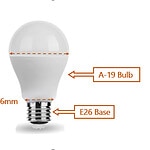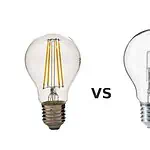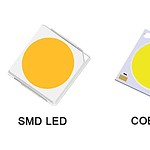You can easily fit an E26 bulb into an E27 socket. But does it mean they are interchangeable? The answer is a big NO!
Though E26 and E27 bulbs are mechanically interchangeable, they are not electrically safe. E26 and E27 bulbs have only a base difference of 1mm, for which they can physically replace one another. But they have different operating voltages. The E26 bulb runs at 120V, whereas the E27 bulb works at 240V. So, installing an E26 bulb in an E27 socket is highly risky as it will overpower the fixture. However, you can use an E27 bulb in an E26 socket, but it won’t give the expected performance.
By the end of this article, you will get to know the major difference between E26 and E27 and the logic behind not to interchange them. So, without any further delay, let’s dive into the discussion-
What Are E26 and E27 Bulbs?
E26 and E27 bulbs indicate the size of bulb bases. Here the term ‘E’ stands for ‘Edison Screwing,’ and the numbers ‘26’ and ‘27’ define the diameter of the bulb base. An E26 bulb has a base of 26mm diameter, and the base diameter of an E27 bulb is 27mm. Though this 1mm difference may seem negligible if considered physical property, they have many differences in application if researched deeply. E26 and E27 bulbs have differences in their voltage ratings, and there is more to know that you will learn in the section below.
E26 Vs E27 Bulbs: The Differences
Knowing the differences between E26 and E27 bulbs is essential to choose the right one for your application. Here are the common facts that differentiate an E26 bulb from an E27:
1. Specifications & Mechanical Differences
The International Electrotechnical Commission (IEC) has set specific standards for E26 and E27 bulbs. According to this standard, the minimum diameter of both E26 and E27 bulbs should be 26.05m. However, the maximum diameter of an E26 bulb can go up to 26.41mm, and for E27, it can extend up to 26.45mm. So, you can see the differences in diameter are negotiable. That is, mechanically, you can interchange both bulbs. You can easily fit an E27 bulb into an E26 socket, and it will fit easily. But the major differences are seen in the length of the screw, height of the insulation cap, and width of the live contact pad.
| Specifications | 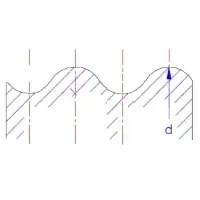 Screw Diameter at Thread Peak | 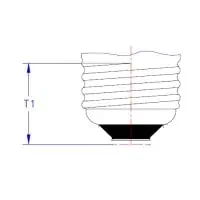 Length of Screw (MIN) |  Insulator Cap Height |  Live Contact Pad Width |
| E26 Bulb | 26.05mm – 26.41mm | 19.56mm | 3.25mm | 9.14mm – 11.56mm |
| E27 Bulb | 26.05mm – 26.45mm | 22.0mm | 5mm | 4.8mm-11.5mm |
The most significant difference between an E26 bulb and E27 bulbs is their screw length. By screw length, it defines the distance from the screw head to the live contact point or bottom of the bulb. The minimum screw length of an E26 bulb is 19.56mm, whereas for an E27 bulb, it is 22.0mm. The reason behind this wide difference is due to their differences in voltage ratings; I will talk about this in the next segment.
Next comes the height of the insulator cap, where you will find a difference of 1.75mm. The insulator cap of the E26 bulb is 3.25mm, whereas the same cap in the E27 bulb has a height of 5 mm. Lastly, the minimum width of the live contact pad of the E26 bulb is 9.14mm, which can extend up to 11.56mm. But in an E27 bulb, the minimum height of the contact pad can be 4.8mm, and the maximum limit can go up to 11.5mm.
2. Voltage and Compatibility
The E26 bulbs are designed to rub at a voltage rating of 120V. Meanwhile, E27 bulbs are compatible with 240V. So, you can see E26 bulbs run at low voltage compared to E27 bulbs. Though you can fit an E26 bulb in an E27 socket, it is not electrically safe. Interchanging the bulbs can cause fire hazards and overpower the bulbs. That is why you should always use an E26 bulb to an E26 socket and an E27 bulb to an E27 socket.
| Type Of Bulb | Voltage Rating |
| E26 | 110V-120V |
| E27 | 220V-240V |
3. Electrical Safety
You have already learned from the above section that E27 works at high voltages and E26 at low voltages. Therefore, the safety precautions of E27 bulbs are more emphasized than those of E26 bulbs. Here are the electrical safety differences between this two categories of bulbs-
- In case the screw alignment of the bulb is not accurate, it will decrease the distance between the live and the neutral contact. Eventually, this will create a possible risk of an electric arc or short circuit. So, to avoid such a situation, the gap between the live and neutral contacts in E27 bulbs is kept greater than in E26 bulbs. Thus, the E27 bulb has a longer screw length which ensures more accuracy when aligning the screws in the socket.
- Moisture and accumulation of dirt increase the risk of short circuits and electrical fires at higher voltage levels. That is why E27 uses a wider thread trough diameter compared to an E26 bulb. This makes the contact tighter and more secure. As a result, the fixture is further shielded from moisture and debris entering the socket.
So, E26 and E27 lamps might be interchangeable and mechanically similar from the perspective of electrical safety. However, there is a higher chance of electrical fires and short circuits when using an E26 lamp in an E27 socket that runs at 240 volts.
4. Regional Compatibility
As there is a voltage difference between E26 and E27 bulbs, you need to take the standard voltage of your country/region. For instance, For example, 110-120V (60 Hz) is used in the United States, whereas 220-240V (50 Hz) is used in many other countries. That is why the E26 bulb is considered standard in countries like- the US, Canada, Taiwan, Japan, etc. Again, European countries and Australia have standard voltage ratings of 240V. So, E27 bulbs are used as standard in these regions.
Is It Safe To Interchange E26 and E27 Bulbs?
Many suppliers and light manufacturers may claim that E26 and E27 bulbs are interchangeable. They will give you logic based on their physical compatibility. You can fit an E26 bulb in an E27 socket and vice versa. But based on their mechanical compatibility, saying they are interchangeable is not correct!
The main reason why you should not interchange an E26 bulb with an E27 is because of their voltage difference. E26 bulbs are designed to run at 120V, and E27 works at 240V. If you install an E26 bulb in an E27 socket, it will get overpowered. As a result, there is a potential chance of damaging the bulb and causing fire breakouts. However, you can use an E27 bulb in an E26 socket. Though it will not provide the E27 bulb with sufficient voltage for maximum performance, it is electrically safe. Yet, it is better to use the E26 bulb to the E26 socket and the E27 bulb to the E27 socket without interchanging them.
How to Choose Between E26 and E27 Bulbs?
When choosing between E26 and E27 bulbs, you should consider some facts. These are as follows-
Bulb Type & Sizes
Both E26 and E27 bulbs are available in various designs and sizes. As these specify the bulb base, not the bulb, you will get a wide range of options. They can be A19, A15, A21, G25, G30, BR30, PAR 20, and more. However, often, the A19 bulb and E26 bulb are thought to be the same thing, which is actually not true. Usually, most A19 bulbs come with an E26 base, which causes confusion. But A19 bulbs with E27 bases are also available. If you are also going through the same confusion, clear this up by reading this article- Are E26 And A19 The Same Thing? However, when deciding the bulb’s size, consider the space’s area and the lighting’s purpose. If you are lighting a congested area, such as a small staircase or a narrow corridor, choose small E26/E27 bulbs. Adding a bulky fixture in these places will look awkward.
Consider Voltage Ratings
To choose between E26 and E27 bulbs, you first need to check the voltage compatibility. For this, take the standard voltage of your region or the voltage rating of your power source. Remember, the E26 bulbs are okay to work at 110V-120V and the E27 bulbs are compatible with 220V-240V. Therefore, match the voltage rating and select the bulb that is suitable for your requirements.
Geographical Location
Have you ever thought you would have to consider your geographical location to select a fixture? It’s funny but true when deciding between E26 and E27 bulbs. As they run at different voltage ratings, you need to consider the standard voltage of your country. If you are located in countries like the US, which uses 110V-120V, go for an E26 bulb. And if you live in any European country, you must choose an E27 bulb. In this region, the standard voltage is 220V-240V. Below, I have added a chart of voltage standards for different counties. This will help you to decide which bulb is compatible with your region- E26 or E27:
| Edison Screw Standard For Different Countries: E26 Vs E27 | |
| E26 Bulbs | E27 Bulbs |
| Anguilla, Aruba, Bahamas, Barbados, Belize, Bermuda, Canada, Cayman Islands, Colombia, Costa Rica, Cuba, Dominican Republic, Ecuador, El Salvador, Guatemala, Haiti, Honduras, Jamaica, Japan, Libya, Mexico, Nicaragua, Panama, Taiwan, Trinidad and Tobago, United States, Venezuela, and the British Virgin Islands. | Afghanistan, Aland Islands, Albania, Algeria, Andorra, Angola, Antigua and Barbuda, Argentina, Armenia, Australia, Austria, Azerbaijan, Bahrain, Bangladesh, Belarus, Belgium, Benin, Bhutan, Bolivia, Bosnia And Herzegovina, Botswana, Bouvet Island, Brazil, British Indian Ocean Territory, Brunei, Bulgaria, Burkina Faso, Burma, Burundi, Cambodia, Cameroon, Cape Verde, Central African Republic, Chad, Chile, China, Christmas Island, Cocos (Keeling) Islands, Comoros, Congo, The Democratic Republic Of The Congo, Cook Islands, Côte d’Ivoire, Croatia, Cyprus, Czech Republic, Denmark, Djibouti, Dominica, Egypt, Equatorial Guinea, Eritrea, Estonia, Ethiopia, Falkland Islands (Malvinas), Faroe Islands, Fiji, Finland, France, French Guiana, French Polynesia, French Southern Territories, Gabon, Gambia, Georgia, Germany, Ghana, Gibraltar, Greece, Greenland, Grenada, Guadeloupe, Guernsey, Guinea, Guinea Bissau, Guyana, Heard Island And Mcdonald Islands, Holy See (Vatican City State), Hong Kong, Hungary, Iceland, India, Indonesia, Islamic Republic Of Iran, Iraq, Ireland, Isle Of Man, Israel, Italy, Jersey, Jordan, Kazakhstan, Kenya, Kiribati, Korea, Kosovo, Kuwait, Kyrgyzstan, Lao People’s Democratic Republic, Latvia, Lebanon, Lesotho, Liberia, Liechtenstein, Lithuania, Luxembourg, Macao, Macedonia, The Republic Of, Madagascar, Malawi, Malaysia, Maldives, Mali, Malta, Martinique, Mauritania, Mauritius, Mayotte, Republic of Moldova, Monaco, Mongolia, Montenegro, Montserrat, Morocco, Mozambique, Myanmar, Namibia, Nauru, Nepal, Netherlands, Netherlands Antilles, New Caledonia, New Zealand, Niger, Nigeria, Niue, Norfolk Island, Norway, Oman, Pakistan, Palestinian Territory, Occupied, Papua New Guinea, Paraguay, Peru, Philippines, Pitcairn, Poland, Portugal, Qatar, Reunion, Romania, Russia, Rwanda, Saint Barthélemy, Saint Helena, Saint Kitts And Nevis, Saint Lucia, Saint Martin, Saint Pierre And Miquelon, Samoa, San Marino, Sao Tome And Principe, Saudi Arabia, Senegal, Serbia, Seychelles, Sierra Leone, Singapore, Slovakia, Slovenia, Solomon Islands, Somalia, South Africa, South Georgia And The South Sandwich Islands, South Korea, Spain, Sri Lanka, St. Vincent, Sudan, Suriname, Svalbard And Jan Mayen, Swaziland, Sweden, Switzerland, Syria, Tajikistan, (United Republic Of) Tanzania, Thailand, Timor Leste, Togo, Tokelau, Tonga, Tunisia, Turkey, Turkmenistan, Turks And Caicos Islands, Tuvalu, Uganda, Ukraine, United Arab Emirates, United Kingdom, Uruguay, Uzbekistan, Vanuatu, Vietnam, Wallis And Futuna, Western Sahara, Yemen, Zambia, Zimbabwe |

Light Technology: Energy Saving and Durability
E26 and E27 bulbs are available in different technologies like- incandescent, halogen, CFL, and LED. But not all these are equally energy-saving. Incandescent bulbs are the traditional ones that consume about 75-80% more energy than the LED ones. So, installing an incandescent bulb is a cheap option, but it will cost you a lot to pay electricity bills in the long run. Again, these bulbs last only 1000 hours, whereas LEDs can run 50,000 or more! So, you will need not replace the LED E26/E27 bulbs as frequently as the incandescent ones. Besides, they use low energy to produce the equivalent lumen output of the traditional fixture. This is why LED bulbs are considered highly energy-efficient bulbs. Below, I’m adding the energy consumption and durability of different types of E26/E27 bulbs to help you choose the best one-
| Criteria of E26/E27 bulbs | Incandescent | Halogen | CFL | LED |
| Brightness | 15 lumens per watt | 25 lumens per watt | 60 lumens per watt | 72 lumens per watt |
| %more efficient than incandescent bulb | – | 28% | 75% | 80% |
| Lifespan | 1000 hours | 2000 hours | 10,000 | 50,000-100,000 |
Brightness and Color Temperature
When securing the brightness and the color temperature of the E26 and E27 bulbs, you must consider the purpose of your lighting. If you aim for task lighting, high-lumen bulbs with greater CCT range are ideal again for accent lighting and bringing a cozy ambiance; opt for low to medium-lumen and lower CCT-rated bulbs. Choosing the correct CCT is very important as it impacts your mood. For instance, high CCT gives off a bluish light that creates a sense of alertness, boosting productivity. In contrast, low CCT provides a yellow hue with a relaxing ambiance. So, if you are looking for an E26/E27 bulb for your bedroom, choose a low CCT one. To learn more about how CCT can affect your mood, check this- How To Use LED Light Colors For Different Moods? However, E26/E27 bulbs of different shapes, sizes, and colors are available for decoration lighting. You will find the use of mini E26/E27 bulbs for outdoor and indoor decorative lighting. Besides, the month of December is running, so you can surely use these bulbs for the upcoming Christmas lighting. For more Christmas decoration ideas, check this- A Compressive Guide To LED Lights For Christmas.
Dimmability
Having a dimmable feature in your bulb allows you to adjust the light intensity and set it to your preferred comfort level. However, not all bulbs come with a dimmable feature. So, if you want more control over your lighting, go for a dimmable one while choosing an E26 or E27 bulb. Thus, you can increase the intensity of light when working in the room and dim it when reading or relaxing. These fixtures come with a dimming switch that helps you adjust the brightness. So you can customize the light intensity as per your requirements.
Smart Features
Smart lighting is a growing popular choice for residential and commercial lighting. They not only give your space a high-tech vibe but are also energy-saving. But are E26 and E27 bulbs available with smart features? The answer is – yes! Many intelligent E26/E27 bulbs can now be integrated with mobile phones. So, you can easily adjust the light brightness from anywhere at any time. More amazingly, some are also compatible with Alexa Voice Control. The lights will get turned on or switched off as you give it voice instructions! Apart from these, having motion sensor-activated E26/E27 bulbs will also save you energy. These fixtures turn on/off, sensing the motion. You can install them in your area’s staircase, hallway, corridor, or pathway. Thus, when you enter the room, the light will turn on automatically, and as you leave the space, the light will turn off. So, there is no misuse of energy, which will save your electricity bills. This gives you greater control over your light settings. You can further make your house a smart home using these smart E26 and E27 bulbs.
Warranty
It is important to purchase an E26 or E27 bulb with at least a warranty of 1 to 3 years. However, most of the branded LED bulbs come with a warranty of 3-5 years. This ensures the fixture is of good quality and thus builds reliability. You should always look for branded fixtures and purchase one from a genuine source where you can approach any time with your warranty card in case you find any issues.

FAQs
Yes, you can use an E27 bulb in an E26 socket. But remember, E27 bulbs are designed to run at 240V; meanwhile, E26 socket supplies 120V. So, though using an E27 bulb in an E26 socket won’t cause any potential risk, the fixture will not get sufficient voltage to illuminate as brightly as it should.
If you interchange E26 and E27 bulbs, E26 bulbs might face safety hazards as they are fitted to a high-voltage E27 socket. As a result, it can cause a fire spark or permanently destroy the bulb. This happens because the E26 bulb runs at low voltage and can only receive 110V-120V; the 220-240V of the E27 socket overpowers it.
E26 bulbs are available in different variants- incandescent, halogen, CFL, and LED. You can interchange any of these with the other till they have an E26 bulb. Besides these bulbs are also available in different shapes and sizes. For example- an A19 bulb with an E26 base can be interchanged with a G40 bulb with the same base. To sum up, you can interchange any two bulbs that have an Edison screw base of 26mm diameter and run at 120V.
Yes, if the LED bulb has an E26 base, you can use it in an E26 socket. It doesn’t matter what type of bulb you are using- incandescent, halogen, or LED; unless they have an E26 base; you can use them in an E26 socket without any second thought. All the bubs with an E26 base are designed to fit in an E26 socket and can receive 110V to 120V that an E26 socket supplies.
The standard size of the bulb varies from one region/country to the other. E26 is considered the ideal bulb size in countries where 110V-120V electricity is supplied. This region includes- the USA, Canada, Japan, Taiwan, and more. Again, in countries where 220V-240V electricity is supplied, E27 bulbs are considered the standard light. So, all the European and most Asian countries use E27 bulbs.
The Bottom Line
To conclude, E26 and E27 bulbs are not interchangeable. The main reason beyond this is their voltage difference; E26 bulbs run at low voltage, whereas E27 bulbs have high voltage. So, if you use an E26 bulb in an E27 socket, it overpowers the bulb. As a result, the bulb gets damaged. However, using an E27 bulb is still okay for fitting an E26 socket. Though it won’t cause any risk of overpowering, the fixture will not get enough voltage to give the best lighting output. Therefore, for safety purposes, you should not interchange an E26 bulb with an E27 bulb.
